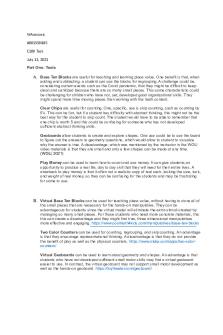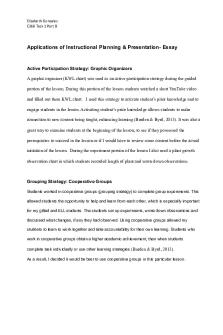C109 performance task PDF

| Title | C109 performance task |
|---|---|
| Author | Kelsey N Johnson |
| Course | Educational Technology for Teaching and Learning |
| Institution | Western Governors University |
| Pages | 10 |
| File Size | 273.5 KB |
| File Type | |
| Total Downloads | 11 |
| Total Views | 194 |
Summary
Download C109 performance task PDF
Description
1
Travis Johnson 01/05/2021 C109, Performance task
Part A. 1. Cuisenaire Rods Cuisenaire rods are good for giving students tactile, visual, and concrete approaches to math concepts that are abstract. Cuisenaire rods are used in the classroom to help students learn about fractions, adding, and subtracting. One of the benefits to using Cuisenaire rods is that they can help students to visualize math problems, which naturally causes the students to have a better understanding of the problems that they are being asked to solve and then solve the problems. One of the challenges to using Cuisenaire rods is that counting numbers by ones can be difficult for addition and subtraction problems. 2. Wild Animal Counters Wild animal counters can be used for helping students develop skills in counting, sorting, comparing, addition and subtraction. Some of the benefits to using wild animal counters are that they support tactile and visual learners explore how to sort shapes and sizes and they can be used for addition and subtraction problems. One of the challenges to using wild animal counters is that students could become too reliant on counters and subsequently not develop the ability to solve addition and subtraction and comparison problems without the use of math counters. 3. Fraction Circles Fraction circles can be used for helping students identify parts to wholes and finding equivalent fractions. One of the benefits to using fraction circles is that they support visual learners when adding parts of a whole number. One of the challenges of fraction circles is that students can become too reliant upon them, therefore, potentially hindering the students from becoming fluent in identifying parts to whole and finding equivalent fractions. 4. Base Ten Blocks Base ten blocks can be used for helping students develop conceptual understanding and spatial skills. Some of the benefits to using base ten blocks are that they can help students improve their skills in learning about place value and comparing two and three-digit numbers. One of the challenges of using base ten blocks is that students may have to rely too heavily on the teacher for assistance in order to gain understanding of how to grasp the specific math concepts that are being explored. Part B. 1. Virtual Number Line The use of a virtual number line is to help students explore the concepts of adding and subtracting. The benefit to using a virtual number line is that students can input numbers directly into the number line to change the line minimums, maximums, and line intervals. One challenge to using virtual number lines is that students who benefit from tactile learning will not have the hands-on tools to help them learn. Web
2
link: http://www.glencoe.com/sites/common_assets/mathematics/ebook_assets/vmf/VMFInterface.html 2. Virtual Base Ten Blocks One of the uses for virtual base ten blocks is that they can be used by students to show the place value concepts. A benefit to using virtual base ten blocks is that students are able to explore adding, subtracting, and measuring concepts. A challenge of using virtual base ten blocks is that the blocks can take large amounts of time to put together the blocks needed for large adding problems such as 750+850=1,600, the blocks can fill up the entire screen. Web link. http://www.glencoe.com/sites/common_assets/mathematics/ebook_assets/vmf/VMF-Interface.html 3. Virtual Calendar The virtual calendar is useful for teaching students about the days of the week and the months of the year. Some benefits of the virtual calendar are the way the calendar can be easily manipulated and changed to showcase different date patterns, and students can explore and easily change around the different dates to help them grasp the concepts of learning the different months, weeks, and days of the year. Some of the challenges of the virtual calendar are that it is limited to measuring nothing smaller than days of the week, so the learning opportunities are limited to days, weeks, months, and years; not time. Web link: http://www.glencoe.com/sites/common_assets/mathematics/ebook_assets/vmf/VMFInterface.html 4. Virtual Place Value Chart The virtual place value chart is useful for teaching and illustrating place value concepts. The benefit to using a virtual place value chart is that students will be provided with a visual representation of various place values of integers. A challenge to using a virtual place value chart is that it the charts are limited to whole numbers. Web link: https://toytheater.com/place-value-chart/
Part C.
Direct Instruction Lesson Plan Template
General Information Lesson Title: Rounding numbers Subject(s): Math Grade/Level/Setting: 3nd grade/ 20 students are at grade level, 5 students are ELLs, one student has ADHD, and 2 students are gifted and talented. Prerequisite Skills/Prior Knowledge: The students will need to be familiar with place value, multiples of 10, and 100.
Standards and Objectives
3
State/National Academic Standard(s): CCSS.MATH.CONTENT.3.NBT.A.1 Use place value understanding to round whole numbers to the nearest 10 or 100. Retrieved from: http://www.corestandards.org/Math/Content/3/NBT/
Learning Objective(s): Given a virtual place value chart, the students will round numbers to the nearest 10 and 100, with 80 percent accuracy.
Materials ●
SMART board
●
Whiteboard
●
YouTube video: https://www.youtube.com/watch? v=K7k3_eiA4UM
●
Dry erase markers
●
Computers
●
Virtual Place Value Chart
●
Hands-on place value/ rounding worksheet
Technology I will show the students an introductory video about place value, using the SMARTboard, that will engage the students in the lesson.
Language Demands Language Function(s): The students will be able to explain about how to round numbers to the nearest 10 and 100.
Vocabulary:
Place value Rounding numbers Estimation of numbers Explain Discuss
4
Discourse and/or Syntax: Discourse: The students will work in pairs and in whole groups to discuss, using oral language, the different ways to round numbers.
Planned Language Supports: The students will participate in whole group discussion to go over the values of ones, tens, hundreds, and thousands. During this whole group discussion is when the concept of rounding and estimating will be introduced.
The Smartboard will be used to write the virtual place value chart.
The students will participate in a turn and talk to your buddy discussion to talk through the different processes of how numbers should be rounded to the nearest number.
Instructional Strategies and Learning Tasks
Anticipatory Set: Activity Description/Teacher The teacher will show the students a fun YouTube video to get them excited about learning place value.
Following the video, the teacher will also review how to count by tens and hundreds.
Student Actions The students will watch the YouTube video about place value.
The students will participate in reviewing how to count by tens and hundreds
Presentation Procedures for New Information and/or Modeling: Activity Description/Teacher The teacher will lead a whole group discussion, introducing the math concepts of rounding numbers, estimation, the importance of why place value and rounding concepts needs to be grasped, and will review the new vocabulary words with the students and ask them questions to check for understanding. Rounding numbers: to change a number to a
Student Actions The students will participate in whole group discussion of rounding and estimating numbers, and the new vocabulary word; they will explain when rounding numbers is appropriate. The students will participate in the white board presentation when the teacher models how and when to round and estimate numbers, the students will ask questions as they arise.
5
more convenient value Estimating: to make an approximate calculation Place value: the value of a digit depending on its place value Explain: to make known, plain, or understandable
The students will then turn and talk to their buddy to discuss, how and why they think place value and rounding are important, and the concepts and processes of rounding to the nearest 10 and 100 are worked out. The students will then be ready to explain and discuss their groups understanding of rounding and estimating to the whole class.
Discuss: to talk about The teacher will use the white board to model examples of rounding and estimating using a place value chart, and will encourage the students to ask questions and share their thoughts. Directly after the whole group discussion, the teacher will have the students turn and talk to their buddy to discuss the new concepts of rounding and estimating numbers. The teacher will then ask each small group to explain to the whole class what their understanding of the concepts of rounding and estimating numbers are. Guided Practice: Activity Description/Teacher
Student Actions
The teacher will use the SMART board to further model the way to round numbers to the nearest 10 and 100 using a virtual place value chart.
The students will engage in the teacher guided presentation of how to round numbers to the nearest 10 and 100, using a virtual place value chart.
The teacher will have the students, one-byone, go to the storage lockers and get their computers,
The students will each get a computer from the storage locker.
The teacher will direct the students, using the SMART board, how to access the virtual place value charts with their individual computers.
The students will then follow along with the teacher so they can access the virtual place value chart.
6
The teacher will then direct the students to begin practicing plotting and rounding numbers in the virtual place value chart.
To help scaffold the students learning, the teacher will then walk around the room taking anecdotal notes and checking for students understanding and giving answers to any questions that may arise and giving the students feedback as they need it.
The students will then begin to practice plotting numbers and rounding numbers to the nearest 10 and 100 in the virtual place value chart.
The students will ask the teacher any questions that that have about place value, estimation, and/ or any of the new vocabulary words as they work through practice problems.
Independent Student Practice: Activity Description/Teacher
Student Actions
The teacher will pass out the place value/ rounding worksheets to the students.
The students will receive their place value/ rounding worksheets from the teacher.
The teacher will then have the students complete the place value/ rounding worksheet; which will include a total of 24 questions, 12 questions that will require students to round number to the nearest 10s place and 12 questions that will require students to round numbers to the nearest 100s place. A few examples of a questions from the worksheet are: when rounding to the nearest ten, what is 92=__, 45=__, and when rounding to the nearest 100 what is 720=__, and 908=__; the answers are: 90, 50, 700, and 900.
The students will then work through the place value/ rounding worksheet, working to completion of all 24 problems on the worksheet. The students will be able to round numbers to the nearest 10 and 100, with 80 percent accuracy.
Culminating or Closing Procedure/Activity: Activity Description/Teacher The teacher will have the students play a Kahoot game, about round numbers, on the
Student Actions The students will login into their Kahoot accounts from their computers, enter the game key, and
7
SMARTboard. The directions for the game would be to have the students round to the nearest tens place. There will be 4 multiple choice options to choose from in the game. An example of a question would be: Joey collects baseball cards; he has a total of 127 baseball cards; about how many baseball cards does joey have in his collection: A. 126, B. 120, C. 125, or D. 130?
enter their names.
The students will play the Kahoot game about rounding numbers.
The answer is D, 130. https://kahoot.com/
Differentiated Instruction Consider how to accommodate for the needs of each type of student. Be sure that you provide content specific accommodations that help to meet a variety of learning needs.
Gifted and Talented: I will have my gifted and talented students engineer a real-world rounding problem, such as when would rounding the nearest 1000 would be appropriate versus rounding to the nearest 100. EL: An accommodation that I would use for my ELL students would include picture vocabulary cards in their native language as well as in English. Students with Other Special Needs: For my student that has ADHD, I will make sure to position the student in front of the classroom, to ensure as little distractions as possible, I will give the student additional directions, and I will give them additional time on the summative assessment.
Assessment Formative: The teacher will lead the students in a group discussion during the presentation procedures for new information and/or modeling portion of the lesson, and during the guided practice section, the teacher will give the students an observational assessment by walking around the room and taking anecdotal notes to check for student understanding and comprehension of the math concepts of place value and estimation of numbers, the teacher will answer any of the students questions, and will provide the students with feedback during this time; this information will be influential in the future lessons that are taught. Summative: I will know the learning objective has been met when given a place value chart and rounding worksheet, the students will round numbers to the nearest 10 and 100, with 80 percent accuracy.
8
Part D. The students used virtual place value charts during the guided practice section to plot and round numbers which will enhance student learning during the lesson. The interactive virtual place value chart helps to engage students and helps them to visually see and understand the numbers they are plotting and rounding. The students will be able to practice working through multiple rounding problems because students will be able to replace the numbers in the place value areas by simply clicking and dragging the numbers onto the chart as many times as they need. The chart also benefits learning by displaying the numbers in expanded form, this will help students to grow their learning of number values by their given positions.
Part E. 1. Conceptual Understanding During this lesson, multiple opportunities for conceptual understanding are incorporated throughout. For example, during the Presentation Procedures for New Information and/or Modeling section the students get to participate in a whole group discussion; this is a great time for the teacher to observe the student’s discussion and check for conceptual understanding as the students are introduced to the new vocabulary words and rounding numbers concepts. The students will also participate in a turn and talk to your buddy activity, which is also a great time for the teacher to observe the students to check for conceptual understanding. During the guided practice section, the students get more opportunities to display their conceptual understanding of rounding and estimating numbers when they work out problems using the virtual place value chart; again, during this exercise the teacher is able to walk around the room, observing the students and checking for understanding, as the students work. During the independent study section, the students get to further demonstrate their conceptual understanding by filling out the place value and rounding worksheet. Even the Kahoot game provides opportunities for students to display their functional grasp of the mathematical concepts of this lesson, and for the teacher to observe the students to check and see if they actual are grasping the concepts of rounding and estimating numbers.
2. Problem Solving Problem solving occurred during the independent, guided practice, and during the closing activity sections of the lesson plan. The students were able to demonstrate their problem-solving skills when they completed the place value and rounding worksheet. The students also got to demonstrate their problem-solving skills during the Kahoot game, when they got to compete against their classmates to see who could round numbers to the nearest ten’s column.
3. Procedural Fluency Procedural fluency is when the students understand the procedures of the math concepts that they were taught. During the presentation of new procedures section of the lesson, the students were able to
9
participate in a turn and talk to your buddy exercise, where they were able to talk though the reasons why it is important to understand the procedures of how to find place value and how to round numbers. During the independent student practice section of the lesson plan, the teacher was able to further assess the students understanding of the procedures of how to find place value and how to round numbers to the nearest 10 and 100 when the students completed their place value and rounding worksheets. And lastly, during the culminating activity, the students got to show off their ability to accurately rounding numbers during the Kahoot game.
Part F. During the presentation procedures for new information and/or modeling section I chose to have the students participate in a turn and talk exercise as part of my instructional strategy. This supported student learning outcomes because it activates prior knowledge and allows students to share their ideas about place value and rounding concepts with their buddy. This process of posing a question to the entire class and then asking them to turn and talk to their buddy will allow the students to organize their thoughts and ideas in their own minds first, then they are able to share their ideas with their peer or buddy, this will get the students ready to share their ideas with the entire group when they are called upon to do so (Berkeley Center for Teaching and Learning, 2021).
10
References
Berkeley Center for Teaching and Learning. (2021). Active Learning Strategies. Retrieved From: https://teaching.berkeley.edu/active-learning-strategies Grade 3: Numbers and Operations in Base Ten. Retrieved From: http://www.corestandards.org/Math/Content/3/NBT/ Kahoot Game. Retrieved From: https://kahoot.com/ Place Value Video. Retrieved From: https://www.youtube.com/watch?v=K7k3_eiA4UM “lakeshore.” Website. Retrieved from: https://www.lakeshorelearning.com/products/math/mathmanipulatives/wild-animal-counters/p/LM986 The First Grade Round-up. Throw Away the Base Ten Blocks. Retrieved From: http://www.thefirstgraderoundup.com/2015/03/throw-away-base-10-blocks.html...
Similar Free PDFs
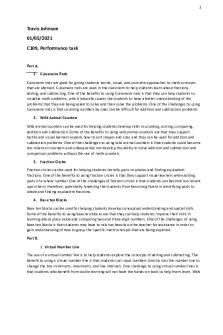
C109 performance task
- 10 Pages

C109 Task 1 - C109 Task 1
- 5 Pages
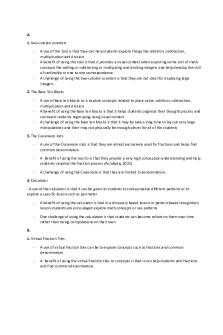
C109 Task 1 wgu.edu
- 8 Pages

C109 Math Methods Task 1
- 6 Pages
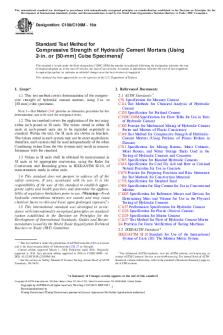
ASTM C109 - ASTM C109
- 10 Pages

Task Performance 2 Finals
- 1 Pages

(08 Task Performance 1)
- 4 Pages

Performance Assessment Task 2
- 4 Pages

05TP1 FM - Task Performance
- 2 Pages
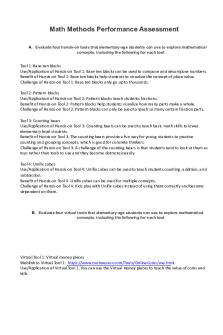
C109-2 - TASK2
- 10 Pages
Popular Institutions
- Tinajero National High School - Annex
- Politeknik Caltex Riau
- Yokohama City University
- SGT University
- University of Al-Qadisiyah
- Divine Word College of Vigan
- Techniek College Rotterdam
- Universidade de Santiago
- Universiti Teknologi MARA Cawangan Johor Kampus Pasir Gudang
- Poltekkes Kemenkes Yogyakarta
- Baguio City National High School
- Colegio san marcos
- preparatoria uno
- Centro de Bachillerato Tecnológico Industrial y de Servicios No. 107
- Dalian Maritime University
- Quang Trung Secondary School
- Colegio Tecnológico en Informática
- Corporación Regional de Educación Superior
- Grupo CEDVA
- Dar Al Uloom University
- Centro de Estudios Preuniversitarios de la Universidad Nacional de Ingeniería
- 上智大学
- Aakash International School, Nuna Majara
- San Felipe Neri Catholic School
- Kang Chiao International School - New Taipei City
- Misamis Occidental National High School
- Institución Educativa Escuela Normal Juan Ladrilleros
- Kolehiyo ng Pantukan
- Batanes State College
- Instituto Continental
- Sekolah Menengah Kejuruan Kesehatan Kaltara (Tarakan)
- Colegio de La Inmaculada Concepcion - Cebu



